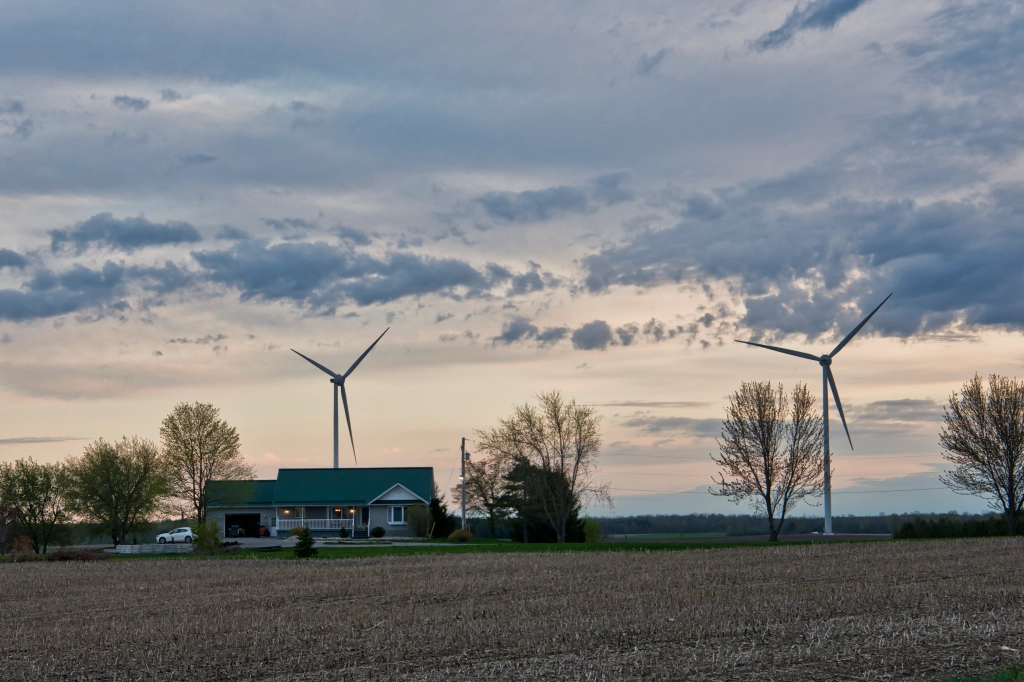by Ottawa Wind Concerns, May 2022
The 29 wind turbines that power the Nation Rise wind farm in North Stormont, 40 minutes south of Ottawa, have been quiet for nine days, since just before the “derecho” chain of thunderstorms that rampaged across Ontario .
The blades on the wind power generators, which are more than 600 feet tall, or equal to 60-storey office buildings in height, are turning gently, but not creating any electrical power.
The result? QUIET. And peace in more ways than that, as not just the audible sound of the turbines has gone, but also the inaudible emissions that humans perceive as pressure and vibration.

Photo: Dorothea Larsen
People who live inside the power project are experiencing a retreat of the physical symptoms that suggest poor health, including headache, ringing in the ears, a sensation of pressure in the chest, and elevated blood pressure and heart rate.
Best of all, say the people who have contacted us, they can sleep.
Long-term sleep disturbance is well documented as a factor in poor health and can have serious consequences including heart disease.
Wind turbines are not a non-emitting source of power. They are known to produce a range of sound emissions, some audible, some inaudible. Ontario’s noise regulations and setback distances for wind turbines — unchanged since 2009, despite more powerful wind turbines — only deal with audible noise.
I can sleep!
Residents contacting Wind Concerns Ontario have commented that since the wind turbines halted operation, not only have symptoms such as headaches and racing heartbeats retreated, they are finally able to sleep at night, and have more energy.

“I used to have to have a nap every afternoon,” said one resident, who said she usually feels exhausted all the time from being wakened frequently in the night. Since the turbines have been off “I have slept unbelievably well.”
Others under the care of cardiologists for what they describe as “racing” heart beats and, in some cases, evidence of heart attacks, also say they are feeling better this week, and feel that their heart health has improved.
One person living near Crysler who has not only turbines but also the transformer substation nearby reported: “all heart palpitations are gone, NO STINGING PAINS Heart is beating normal blood pressure is normal all in 4 days as the turbines stay off“.
Symptom disappearance an indication of harm
According to a paper written by physician Dr Robert McMurtry an medical researcher Carmen Krogh, published in 2014, there is a list of symptoms that are suggestive of harm being done by exposure to wind turbine noise emissions.
And, a key indicator that harm is being caused could be what happens when people leave their home environment. Krogh and McMurtry wrote: “Significant improvement away from the environs of wind turbines and a revealed preference for sleeping away from home serve to distinguish between AHE/IWT from other conditions.“
Ottawa ignoring adverse effects
It is worrying that the City of Ottawa, perhaps 40 minutes away from Nation Rise, has created a strategy for electrification and “Net Zero” in its Energy Evolution document. A model in the strategy calls for 3,200 megawatts of wind power or more than 700 industrial-scale wind turbines in the rural areas of that city.
And the Government of Ontario will soon release a Request for Proposals for 1,000 megawatts of new power generation, some of which might be from wind energy.
Meanwhile, the problems with existing wind turbines have not been addressed: the government (under premiers McGuinty, Wynne and Ford) has thousands of files* of reports of noise pollution and other effects from wind turbines, but enforcement is lax.
Wind Concerns Ontario did a review of operating wind power projects to determine the status of the required audits to verify compliance: only 43 percent have completed and accepted audits.
It is a violation of the Environmental Protection Act or EPA of Ontario to cause an adverse effect. “Adverse effect” is defined in the Act.
“adverse effect” means one or more of,
(a) impairment of the quality of the natural environment for any use that can be made of it,
(b) injury or damage to property or to plant or animal life,
(c) harm or material discomfort to any person,
(d) an adverse effect on the health of any person,
(e) impairment of the safety of any person,
(f) rendering any property or plant or animal life unfit for human use,
(g) loss of enjoyment of normal use of property, and
(h) interference with the normal conduct of business; (“conséquence préjudiciable”)
Co-owners of the Nation Rise power project are EDP Renewables and the Algonquins of Pikwakanagan who have a contract extending to 2041. Obviously, the wind turbines will start operating again, but it is unknown what the effects will be for people living near Nation Rise wind turbines as the turbines resume operation.
Wind Concerns is a collaboration of citizens of the Lakeland Alberta region against proposed wind turbine projects.


